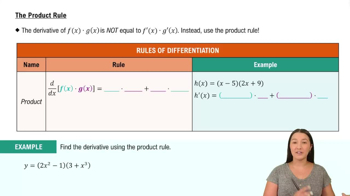Calculate the first derivatives of ƒ(𝓍) = 𝓍²/ (𝓍² + 1) and g(𝓍) = ―1/ (𝓍² + 1) . What can you conclude about the graphs of these functions?
Table of contents
- 0. Functions7h 54m
- Introduction to Functions16m
- Piecewise Functions10m
- Properties of Functions9m
- Common Functions1h 8m
- Transformations5m
- Combining Functions27m
- Exponent rules32m
- Exponential Functions28m
- Logarithmic Functions24m
- Properties of Logarithms36m
- Exponential & Logarithmic Equations35m
- Introduction to Trigonometric Functions38m
- Graphs of Trigonometric Functions44m
- Trigonometric Identities47m
- Inverse Trigonometric Functions48m
- 1. Limits and Continuity2h 2m
- 2. Intro to Derivatives1h 33m
- 3. Techniques of Differentiation3h 18m
- 4. Applications of Derivatives2h 38m
- 5. Graphical Applications of Derivatives6h 2m
- 6. Derivatives of Inverse, Exponential, & Logarithmic Functions2h 37m
- 7. Antiderivatives & Indefinite Integrals1h 26m
- 8. Definite Integrals4h 44m
- 9. Graphical Applications of Integrals2h 27m
- 10. Physics Applications of Integrals 3h 16m
- 11. Integrals of Inverse, Exponential, & Logarithmic Functions2h 31m
- 12. Techniques of Integration7h 41m
- 13. Intro to Differential Equations2h 55m
- 14. Sequences & Series5h 36m
- 15. Power Series2h 19m
- 16. Parametric Equations & Polar Coordinates7h 58m
4. Applications of Derivatives
Differentials
Problem 3.9.18
Textbook Question
Derivatives in Differential Form
In Exercises 17–28, find dy.
y = x√(1 − x²)
 Verified step by step guidance
Verified step by step guidance1
Step 1: Identify the function y = x√(1 − x²). This is a product of two functions: x and √(1 − x²).
Step 2: Apply the product rule for differentiation, which states that if you have a function y = u*v, then dy/dx = u'(v) + u(v'). Here, let u = x and v = √(1 − x²).
Step 3: Differentiate u = x with respect to x, which gives u' = 1.
Step 4: Differentiate v = √(1 − x²) with respect to x. Use the chain rule: v' = (1/2)(1 − x²)^(-1/2) * (-2x). Simplify this expression.
Step 5: Substitute u', v, u, and v' into the product rule formula: dy/dx = u'(v) + u(v'). Simplify the expression to find dy/dx.
 Verified video answer for a similar problem:
Verified video answer for a similar problem:This video solution was recommended by our tutors as helpful for the problem above
Video duration:
5mPlay a video:
Was this helpful?
Key Concepts
Here are the essential concepts you must grasp in order to answer the question correctly.
Derivative
The derivative of a function measures how the function's output changes as its input changes. It is a fundamental concept in calculus, representing the rate of change or slope of the function at a given point. For a function y = f(x), the derivative is denoted as dy/dx and can be found using various rules such as the power rule, product rule, and chain rule.
Recommended video:

Derivatives
Product Rule
The product rule is used to find the derivative of a product of two functions. If y = u(x)v(x), where both u and v are functions of x, the derivative dy/dx is given by u'(x)v(x) + u(x)v'(x). This rule is essential when dealing with functions that are multiplied together, as in the given problem y = x√(1 − x²).
Recommended video:

The Product Rule
Chain Rule
The chain rule is a method for finding the derivative of a composite function. If a function y = f(g(x)) is composed of two functions, the derivative dy/dx is found by multiplying the derivative of the outer function by the derivative of the inner function: f'(g(x))g'(x). This rule is crucial when differentiating functions like √(1 − x²), where the inner function is 1 − x².
Recommended video:

Intro to the Chain Rule

 5:53m
5:53mWatch next
Master Finding Differentials with a bite sized video explanation from Patrick
Start learningRelated Videos
Related Practice
Textbook Question
